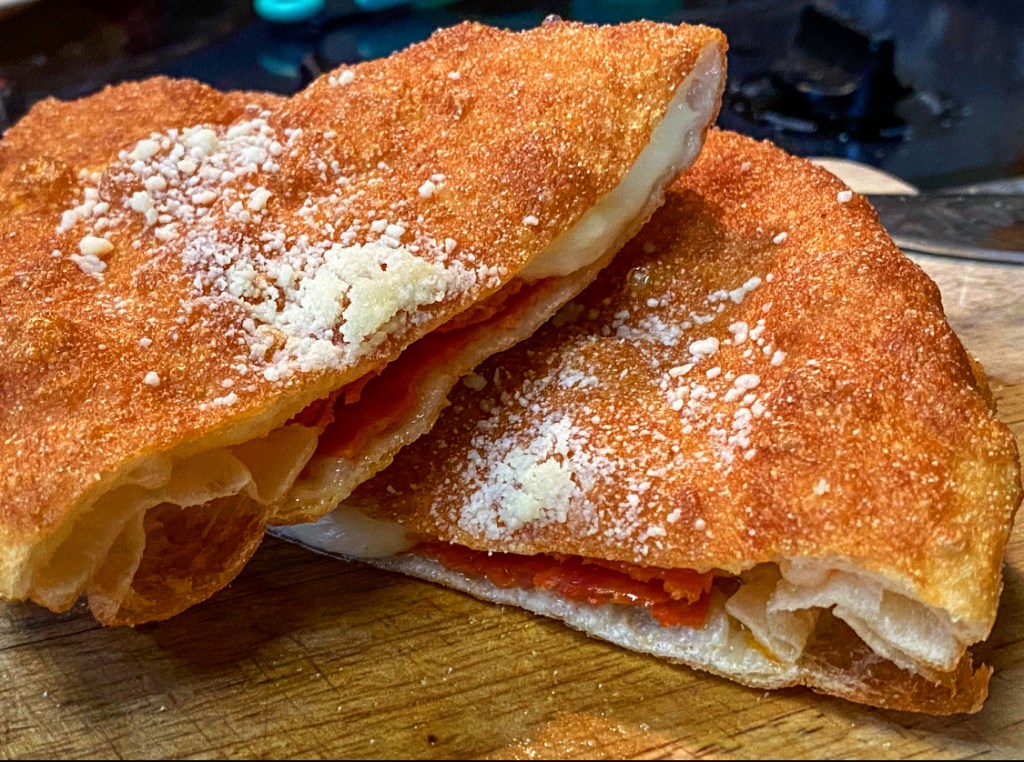It is my earnest opinion that calzones are underrepresented and underrated in the world of pizza.
This did not occur to me until January 2015, when I binge-watched the show Parks and Recreation during an illness, which featured Adam Scott’s character routinely proclaiming his affinity for calzones, only to be scoffed at by the other characters.
There is a local restaurant by me who consistently serves mediocre pizza (and for that reason, I will not call them out by name), but their calzones are spectacular. In contrast to the pale, flavorless pizza, their calzones are properly browned in the oven and topped with a garlic and herb butter that makes it stand out. The proper browning and the garlic and herb butter is not mentioned on the restaurant’s menu. It is almost a secret, which is a shame.
In the online pizzamaking circle, calzones are virtually viewed as an afterthought. I learned this, after I started my own pizza journey, and the “calzone means ‘pizza fail‘ in Italian” meme was often parroted by snarky jesters. I learned the origin of such a comment when, early in my pizzamaking days, I erroneously caused a hole in my dough during the stretching process, and my only saving grace was to fold the dough over, essentially creating a recovery calzone. The hole represented not only a ‘pizza fail’ of my own but a vent for steam to escape from the toppings inside the pocket of dough.
‘Pizza fail’ or not, there is something to be said about the deliciousness of a calzone, when adequately constructed and cooked. Just like a pizza, it is a handheld delight: a pocket of dough filled with ooey, gooey cheese and desirable innards.
‘Desirable innards’ is a poor choice of words, a step down from ‘pizza fail in Italian’, so what really is a calzone? Well, once it is folded in half it is a half-moon pizza after you stretch pizza dough into a skin and add the filling. Classically, a calzone’s first requirement is ricotta, but — although a delicious inclusion — I resent that stipulation after eating many calzones over the years that did not feature ricotta. Readers, correct me if I’m wrong, but I believe the original calzone is simply a mix of mozzarella and ricotta, with the dough sealed shut, ensuingly baked and thereafter served with marinara sauce for dipping.
I rarely make calzones, so my letter of defense is starting to deflate, like over-proofed dough. However, there is one form of cooking a calzone that will change your world and, if you eat enough of this decadent iteration, will cause you to start shopping for bigger jeans.
The Deep-Fried Calzone (Panzerotti)

I am not one to make excited noises when I eat something delicious; I often think people who do such a thing are exaggerating for the sake of effect and attention. My reaction to what is essentially a pleasure bomb, or tastebud tingler, is to emphatically say, “holy shirts and pants!” except that I don’t say shirts, and or pants.
That is what happened when I cooked, and tasted, panzerotti for the first time in my life.
It shouldn’t have been a surprise. Isn’t the notion that everything deep-fried is automatically delicious a truth known to be self-evident? Surely so, but the sheer flavor, texture and dopamine increase from satiating your appetite with this sinfully delicious treat, whether you call it a deep-fried calzone, panzerotti or a ‘deep-fried pizza pocket emanating from the pearly gates of pizza heaven’, will transcend your appreciation for pizza-related cuisine tenfold (speaking of dough and folding).
Panzerotti (which is plural for panzerotto) comes from southern Italy; ‘panza‘ being the diminutive word meaning ‘belly’ or ‘tummy’ in Italy, referring in this case to the distinctive swelling of the dough which resembles a swollen belly. Panzerotti is a small calzone that is fried (hence the additional name, calzoni fritti in Italy). Think of an empanada, although instead of a pastry, it is a mini calzone.
How to Make a Deep-Fried Calzone (Panzerotti)

Oftentimes, when you cook up some delicious grub, the trade-off is either a lot of hard work, an egregious expenditure of time or complicated ingredients. One can debate there’s substantial time in creating a deep-fried calzone (as far as fermenting the dough is concerned), but I would argue that patience is the more practical, applicable word. This is all you need:
- Dough
- Cooking oil
- A heavy, sturdy pot
- ‘Toppings’ or what you want to stuff the calzone with (meat, cheese, cooked vegetables
- A slotted spoon
- A scale (if making homemade dough)
It’s All About the Dough
If you so desire, go ahead and use store-bought dough. This is a deep-fried dish and nobody will scoff at you for doing so (see the aforementioned note regarding deep-fried foods from earlier), but homemade dough is easy and much healthier (the word ‘healthier’ is subjective and sounds ludicrous in a post about deep-frying, but I’m referring to the absence of needless additives and preservatives) than store-bought dough.
If you are using store-bought dough, move forward to the next section, but here is my recipe (baker’s percentages included) for a homemade dough specifically concocted for panzerotti:
- 710g bread flour (100%)
- 433g room temperature water (61%)
- 2.8g instant dry yeast (0.4%)
- 14g sea salt (2%)
- 28g olive oil (4%)
- 10g granulated sugar (1.5%)
These ingredients will yield six calzones (200g dough balls).
Mix by hand or with a stand mixer. I used a stand mixer, and my process is quite cut-and-dry with a dough hook attached:
- Add the flour, yeast, water, sugar and salt to mixing bowl.
- Mix on speed 1 until just about all the flour is absorbed (about two to four minutes).
- Add the olive oil.
- Mix on a higher speed for another two to four minutes until the dough is looking supple and fairly smooth.
- Either cover the dough with plastic wrap or toss it into a bowl, covered, for an hour or two for a bulk ferment.
- Separate the dough into six taut balls and add them to individual (lightly oiled to prevent sticking) 6-cup containers or a proofing box before popping them into the fridge for at least two days.
Note: I don’t spend much time mixing, or kneading, pizza dough. The reason being is because I typically make the dough at least two days (I prefer three) ahead of time. Biochemical gluten formation occurs when you do this, as the dough sits in the refrigerator. Gluten strengthens over time. If I were making a same day (or one day) dough, I would knead for longer (with more yeast involved). Don’t sweat the small stuff. The most important thing is making sure your dough is cohesively coming together.
The Panzerotti Process

This is the fun part: you have waited, and now Bruce Buffer is yelling, “It’s time!” in your head (or not). You can bust out a rolling pin if you want to (I recommend not doing so), but the best part about this dough is its hydration level (61%) is the sweet spot. It’s not too high to where it is going to be hard to work with, but it’s also not too low where it will be stiff and resistant to stretch. The important thing is allowing your dough to come to room temperature before opening it into a skin.
- Remove dough balls from the fridge and sit them out for an hour or two. I went with two hours, because the room was rather cool.
- Heat up a pot of cooking oil (about three to five inches of oil; I’m overzealous so I likely overdid it) to 350 degrees F.
- Working on a clean counter or dough mat, add flour to your working surface
- Carefully handling the dough ball with a floured hand, sit it onto the the floured working surface before topping the dough ball with additional flour.
- Gently open the dough into a skin by pressing around the edges of the dough and then further opening it with a ‘steering wheel’ stretch (example).
- Keeping the dough round, stretch it to about 8 inches
- Apply meat and/or vegetables and cheese to the middle of the dough skin.
- Fold the top part of the dough over the bottom half and press in. Make sure to seal the dough off completely.
- Use a pizza cutter to remove excess dough
- Carefully lift the calzone and gently place it into the hot cooking oil
- Fry for 2-3 minutes on one side; using a slotted spoon, carefully turn the calzone over to cook for another 2 minutes.
- Remove and place on a wired cooking rack to drain.
- Optional: top with a little bit of grated parmesan cheese
- Wait five minutes
- Enjoy the tastebud explosion that is a deep fried calzone. Serve with marinara, pesto, ranch or whatever it is that gets you going.
What to do With the Excess Dough


I mentioned in the recipe process above that you should remove the excess dough. Why? Well, I have one indulgent reason: dessert. Pinch off pieces of the dough that you removed, roll them into a ball, fry them for a couple of minutes, remove from the cooking vessel, drain and — in a bowl — dust with powdered sugar and shake them up. The result is something tantamount to county fair style fried dough or funnel cake bites.


Leave a comment